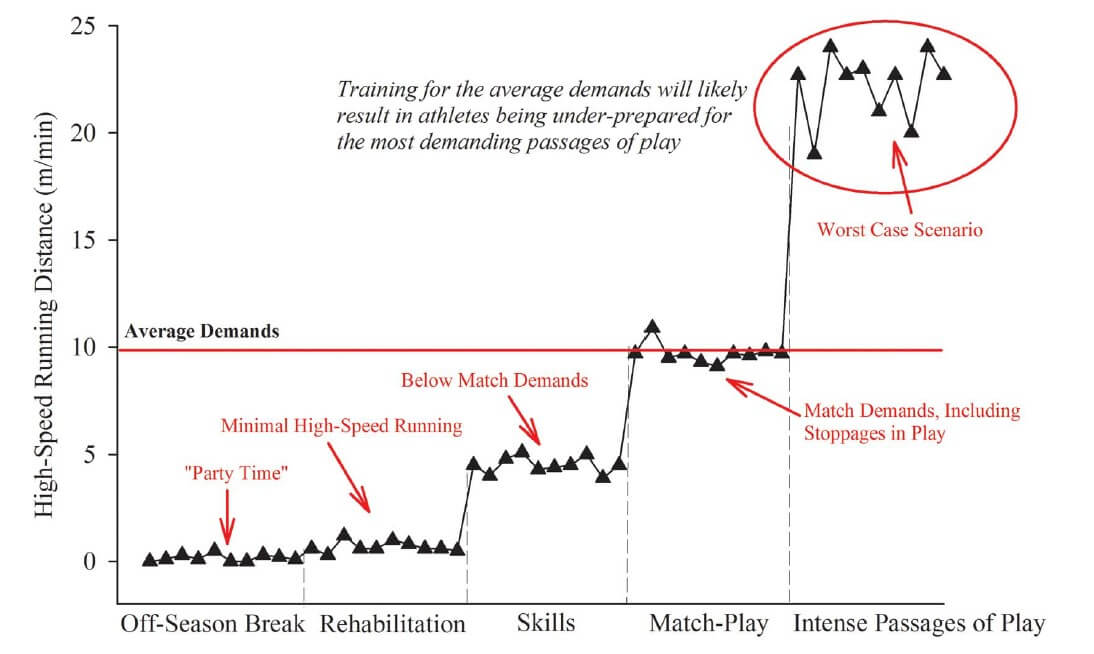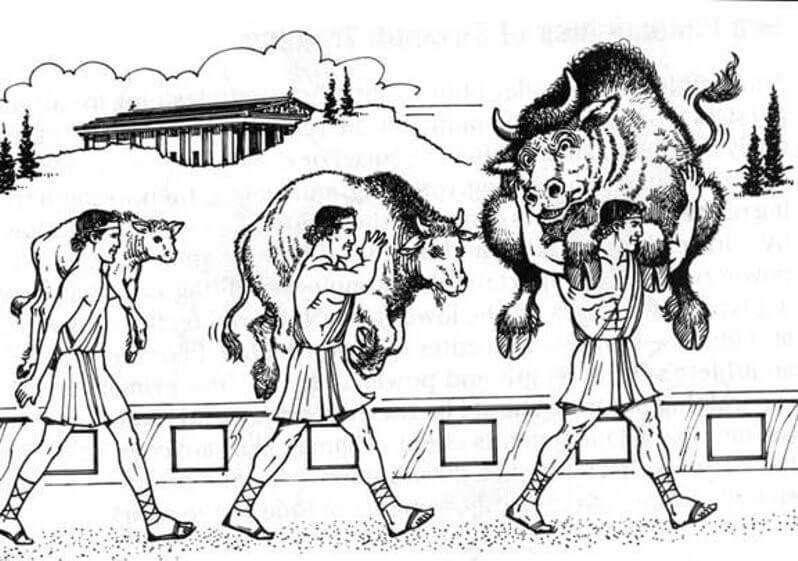Just Tell Me What I Need to Know!
Anyone who has worked with sports coaches understands they have competing demands. Not only are they required to devise an overall strategy for the team to execute, but they need to liaise with administrators (e.g. the chairman and the board), sponsors, and media, manage rosters, assistant coaches, and individual athletes (and their unique personalities), and play a key role in the day-to-day planning of technical, tactical (and sometimes) strength and conditioning sessions. There is no doubt that the principles of load management are important for coaches to understand, but coaches are time poor! With all of the athlete monitoring and workload management resources that are available, it is not surprising when coaches exclaim “Just tell me what I need to know!” This article provides a user-friendly guide for practitioners when describing the general purpose of load management to coaches.
1) Build Chronic Loads
Injury occurs when load exceeds the ability of the tissue to adapt (i.e. when load is greater than load capacity). Consequently, for many years it was believed that injuries occurred as a result of high training loads. However, a large number of studies have recently shown that high chronic loads are associated with lower injury risk (1). These findings have been confirmed across multiple sports and research groups. Of equal interest is the influence of high chronic load on performance. In the mid-1990s, Foster et al. (2) studied the performance of runners, cyclists and speed skaters and demonstrated that performance was closely linked to training load; athletes with higher training loads had faster time-trial performances. Team sport performance can also be explained, at least in part by training load (3, 4). It appears that appropriately high chronic training loads reduce injury risk and enhances athlete performance in several ways. Firstly, exposure to load helps athletes withstand subsequent load. Secondly, appropriately prescribed training develops physical qualities that not only protects against injury but allows athletes to perform the high-intensity tasks required of competition.
Sign up for the Certificate in Workload and Injury in Team Sports, designed by Tim Gabbett
2) Prepare for the “Worst Case Scenario”
The “worst case scenario” refers to the most demanding passage of match-play. These passages of play occur at critical moments of competition (e.g. shots on goal, goals scored or conceded), and are often termed “repeated-sprint” (e.g. football, field hockey) or “repeated high-intensity effort” (e.g. basketball, rugby, ice hockey) bouts. The ability (or inability) to perform these repeated high-intensity efforts often prove critical to the outcome of competition. Indeed, we recently showed that a large percentage of tries scored in rugby league competition occurred in close proximity to a repeated high-intensity effort bout (5). These demanding passages of play should therefore be viewed as an “opportunity” to gain ascendency over an opponent. Exposing athletes to the most demanding passages of play in training on a regular basis (with adequate rest), improves their ability to tolerate those demands in competition. Afterall, if training programs focus on the average demands of competition and neglect to target the most demanding passages of play, then at best, athletes can only ever be prepared for 50% of competition (Figure 1).

3) Get There as Safely as Possible
“Milo of Croton” was a 6th century BC wrestler who won many events in the ancient Greek athletic festivals. As legend has it, Milo carried a fully grown bull up a mountain for slaughter. It is believed he achieved these feats of strength by first lifting a calf in his formative years, and every day thereafter, carrying the calf until it had developed into a fully-grown animal (Figure 2). In modern terms, Milo of Croton demonstrated the training principle of progressive overload. Overload in training is required in order for the body’s tissues (e.g. bone, muscle, tendon) to adapt and tolerate further stress. However, if the increment in load is too rapid, then the capacity of the tissue to tolerate that stress is exceeded (see point #1 above), resulting in damage, or in severe cases, rupture of the tissue. Although there are several methods of progressing training loads (e.g. 10% increases in load from week-to-week), recently, we have described the acute:chronic workload ratio (ACWR) as a safe and systematic method of progressing training loads (7). The results of this research (which has been replicated by over 35 different studies and 11 different sports) (1) demonstrates that large “spikes” (i.e. rapid increases) in training load increase injury risk. However, smaller increases in load result in considerably lower injury risk.

What Do You Want from Your Athlete?
Building to high chronic workloads, preparing for the most demanding passage of play, and systematically and safely progressing workloads are simple but sound coaching principles. When coaches state “Just tell me what I need to know!”, perhaps the best response is to ask them what they would like from their athlete. What do they want their athlete to be able to achieve during competition? Responses can be wide and varied but typically include: “I want them to be fit!”, “I want them to handle whatever the game throws at them!”, and “I want them available!”. What coach wouldn’t want their best players fit, firing, and ready for “battle”? Following the 3 simple steps described in this article provides coaches with a great opportunity to achieve this aim.
By Professor Tim Gabbett and the Gabbett Performance Solutions team
Tim Gabbett, High Performance Consultant. 20 years experience working as an applied sport scientist with athletes and coaches from a wide range of sports. Expert of the Certificate in Workload and Injury in Team Sports at Barça Innovation Hub – Universitas.
References
1.Gabbett TJ. Debunking the myths about training load, injury and performance: Empirical evidence, hot topics and recommendations for practitioners. Br J Sports Med 2018; in press.
2. Foster C, Daines E, Hector L, et al. Athletic performance in relation to training load. Wisc Med J 1996;95;370-374.
3. Aughey RJ, Elias GP, Esmaeili A, et al. Does the recent internal load and strain on players affect match outcome in elite Australian football? J Sci Med Sport 2016;19:182-186.
4. Lazarus BH, Stewart AM, Hopkins WG, et al. Proposal of a global training load measure predicting match performance in elite sport. Front Physiol 2017; Nov 21;8:930. doi: 10.3389/fphys.2017.00930. eCollection.
5. Gabbett TJ, Gahan CW. Repeated high-intensity effort activity in relation to tries scored and conceded during rugby league match-play. Int J Sports Physiol Perform 2016; in press.
6. Gabbett TJ, Kennelly S, Sheehan J, et al. If overuse injury is a “training load error” should undertraining be viewed the same way? Br J Sports Med 2016;50:1017-1018.
7. Gabbett TJ. The training—injury prevention paradox: should athletes be training smarter and harder? Br J Sports Med 2016;50:273-280.
KNOW MORE
CATEGORY: MARKETING, COMMUNICATION AND MANAGEMENT
This model looks to the future with the requirements and demands of a new era of stadiums, directed toward improving and fulfilling the experiences of fans and spectators, remembering “feeling” and “passion” when designing their business model.
CATEGORY: FOOTBALL SPORTS PERFORMANCE
Through the use of computer vision we can identify some shortcomings in the body orientation of players in different game situations.
CATEGORY: MEDICINE HEALTH AND WELLNESS
A health check must detect situations which, despite not showing obvious symptoms, may endanger athletes subject to the highest demands.
CATEGORY: FOOTBALL TEAM SPORTS
In the words of Johan Cruyff, “Players, in reality, have the ball for 3 minutes, on average. So, the most important thing is: what do you do during those 87 minutes when you do not have the ball? That is what determines whether you’re a good player or not.”
CATEGORY: MEDICINE HEALTH AND WELLNESS SPORTS PERFORMANCE
Muscle injuries account for more than 30% of all injuries in sports like soccer. Their significance is therefore enormous in terms of training sessions and lost game time.
DO YOU WANT TO KNOW MORE?
- SUBSCRIBE
- CONTACT
- APPLY
KEEP UP TO DATE WITH OUR NEWS
Do you have any questions about Barça Universitas?
- Startup
- Research Center
- Corporate